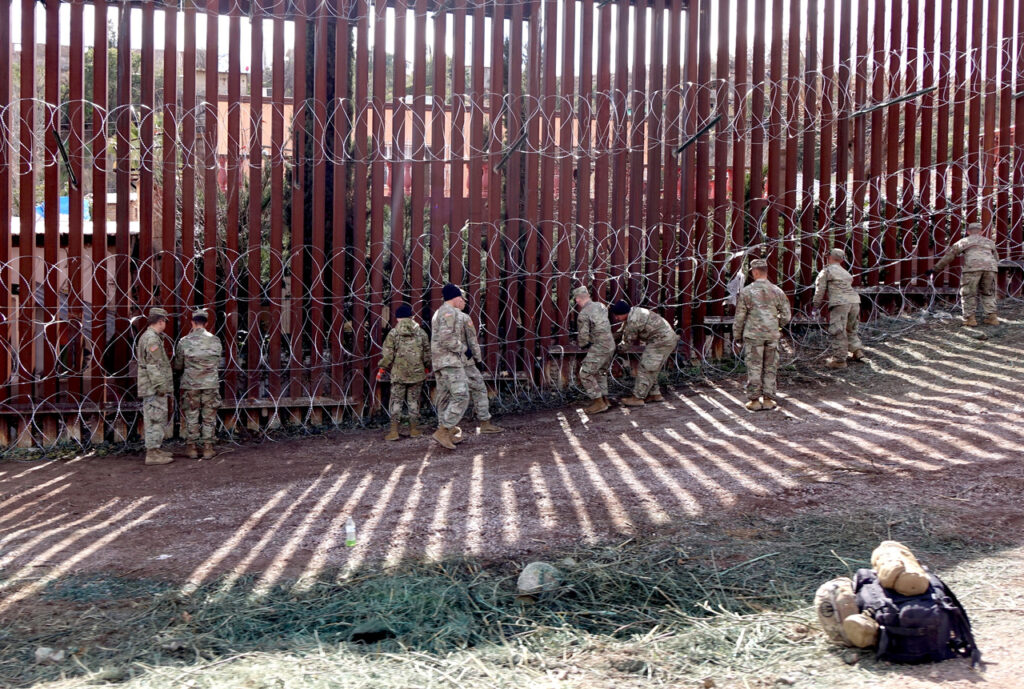
Wish List: What New Weapons Made It Into Biden’s Defense Budget?
Here’s What You Need to Remember: However, the Army has protected funding for thirty-five modernization programs including new artillery, missiles, and infantry fighting vehicles, as well as $24 billion for thirty “key enabler” technologies. In R&D the service is nursing along its MPF light tank program ($237 million), long-range hypersonic missiles ($4.12 million), Future Vertical Lift helicopter program (1.12 billion), and Mid-Range Capability missiles ($286 million).
On May 28, the Department of Defense released its $752.9 billion defense budget request for 2022—a document which will almost certainly be subject to the extensive back-and-forth in Congress before being signed into law.
Though the budget will certainly be revised, it nonetheless serves as a guide to the Biden-era Department of Defense’s priorities, with a record $112 billion devoted to research and development of future technologies at the expense of reducing forces in the near term. This seemingly is based on the premise that there is a limited short-term risk of major conflict, but that there is a need to secure technological overmatch versus the maturing military capabilities of China in the next decade.
Here are five key takeaways to take from the proposed budget with a focus on procurement and technology.
U.S. Defense Spending Is Remaining Flat
Setting aside about $38 billion allocated to the defense-related programs in the Department of Energy and other agencies, the proposed budget dedicates $715 billion dollars to the Department of Defense, a 1.6 percent increase over the $703.7 billion 2020 budget, in line with inflation. That means it’s essentially a flat budget, to the dismay of left- and right-wing lawmakers for opposite reasons. The new budget, incidentally, also includes a 2.7 percent pay raise for personnel.
Republicans favored increased defense spending for military competition with a rising China. More left-leaning Democrats wanted spending cuts, arguing that U.S. spending dwarfed that of adversaries, encouraged military adventurism, and detracted from providing for the welfare of American citizens. The flat budget is thus a predictable outcome of Biden’s centrist inclinations.
Full Speed Ahead on Nuclear Triad Modernization
Obama initiated, and the Trump administration enthusiastically embraced, a hugely expensive program (estimated $1.2 trillion) to broadly recapitalize the U.S. triad of air, sea- and land-based strategic nuclear weapons. The $100 billion GBSD program, which seeks to replace 400 land-based Minuteman III intercontinental ballistic missiles (ICBMs), has particularly come under fire (including by the author) for its cost and lack of flexibility compared to air- and sea-based nuclear deterrence.
But the 2022 budget shows the Biden administration is firmly behind full triad modernization, with $2.6 billion in funding for the GBSD intercontinental ballistic missile (an increase of $1.1 billion over 2020) and $609 million devoted to the moderately controversial air-launched LRSO stealth nuclear-tipped cruise missile.
The Air Force Wants to Shed 200 Older Aircraft
Older ships and aircraft are expensive to upgrade and become more costly to maintain as metal fatigues and spare parts become scarce. For that reason both the Navy and Air Force want to downsize their inventory aggressively, preferring to procure or develop successor platforms instead.
In terms of combat aircraft, that means pawning off forty-eight older F-15C/D air superiority fighters, forty-seven F-16C/D tactical multi-role fighters, and forty-two A-10 ground attack jets. Lawmakers (particularly those from Arizona) will likely contest downsizing the A-10 force.
The service also wants to cull old support aircraft, including eighteen KC-135 and fourteen KC-10 tankers, four (out of sixteen) E-8 JSTARS flying command centers, thirteen C-130H transport aircraft, and twenty not-so-old RQ-4 high altitude surveillance drones deemed non-survivable in a conflict with China or Russia. The tankers are set to be replaced by new KC-46A Pegasus tankers (which don’t work yet), while the E-8s and RQ-4 capabilities will be replaced by a land-based Advanced Battle Management System (ABMS), which is in the early stages of development ($204 million requested). Flying hours are also being reduced to reflect disengagement from Afghanistan.
The Air Force meanwhile is procuring forty-eight new F-35A stealth jets ($4.5 billion), twelve more F-15EX multi-role fighters ($1.3 billion), fourteen KC-46As ($2.5 billion), three MC-130J special operations transport aircraft, and fourteen HH-60W rescue helicopters. F-35 orders, which total eighty-five including Navy and Marine Corps F-jets) might be increased by Congress again, but some analysts think that’s unlikely given recent negative press surrounding F-35 operating costs.
The Air Force R&D spending has increased by $2.2 billion to $28.8 billion, including $2.9 billion for developing the B-21 stealth bombers, $1.5 billion on the sixth-generation Next Generation Air Dominance stealth fighter to replace the F-22 Raptor, $1.1 billion for the Block 4 F-35 upgrade, and $716 million on upgrading B-52 bombers with new radars and more fuel-efficient engines. $161 million is also going to the initial production of twelve AGM-183A Arrow hypersonic missiles for use by B-52s and F-15EXs. The service is also exploring a low-cost F-16 replacement. Space Force has also increased to $20.6 billion, with funding for satellites and five new launch vehicles.
The Navy Doesn’t Want to Pay for Really Old Ships—Or Broken New Ones
Meanwhile, the Navy wants to accelerate the retirement of seven Ticonderoga-class cruisers, as modernizing these powerful but aging vessels have jumped two to three times the expected price. The cruisers pack a great deal of firepower, but missile defense-capable Flight III Arleigh Burke-class destroyers may be a viable substitute.
The services also controversially want to retire one more Independence-class and three Freedom-class littoral combat ships, types plagued by high costs and limited capabilities. In 2020 the Navy was allowed to retire two early test ships that would have required large sums to upgrade to operational status. This year’s request calls for retiring two additional test ships, as well as two Freedom-class LCSs that have experienced engine breakdowns requiring costly repairs. The remaining Littoral Combat Ships will receive a major firepower upgrade with the installation of Naval Strike Missiles.
Meanwhile, the Navy is ordering two new Virginia-class attack submarines ($6.9 billion), one new Arleigh Burke-class destroyer ($2.4 billion), and a first-in-class Constellation-class frigate ($1.3 billion) hoped to succeed the LCS. Four more support ships are also on the docket, totaling $1.47 billion: ocean surveillance ships, two tow/rescue vessels, and an oiler.
About $7 billion is also going towards the ongoing construction of two new Gerald Ford-class carriers and the lead Columbia-class nuclear-powered ballistic missile submarine.
These numbers will not please politicians fixated on increasing U.S. Navy ship count. However, the Navy can’t significantly increase shipbuilding with the current allocation.
The Army budget contracts—slightly
The Army is requesting only $173 billion in funding—down from $178 billion it requested the prior year, $176.6 of which was finally approved. By contrast, the Navy’s request is $3.8 billion higher for a total of $211.7 billion.
Due to high operating costs, Navy proponents lately are arguing the service should receive a cut of Army funding, arguing that the U.S. is gradually wrapping up long-running land wars in Iraq and Afghanistan, while it’s increasingly competing with China around the Indo-Pacific where air and sea power reign.
The 2022 budget reflects that trend but isn’t the kind of large-scale transfusion of Army funding Navy advocates want. To be fair, the Army remains more important in European security roles vis-a-vis Russia, and the service is also investing in new ways to sink ships.
The Army had already recently implemented extensive “night court” cuts to afford its Big 6 modernization initiative. With little fat left to trim, the service instead is reducing by around 70 percent the procurement of new systems, including twenty-five M109A7 PIM howitzer, thirty remanufactured AH-64E Apache Guardian attack helicopters, 187 up-gunned Stryker armored personnel carriers, and seventy defensive upgrades to M1 Abrams tanks. Eight modernization programs have also been canceled outright including new tactical jammers and missile and rocket launchers.
However, the Army has protected funding for thirty-five modernization programs including new artillery, missiles, and infantry fighting vehicles, as well as $24 billion for thirty “key enabler” technologies. In R&D the service is nursing along its MPF light tank program ($237 million), long-range hypersonic missiles ($4.12 million), Future Vertical Lift helicopter program (1.12 billion), and Mid-Range Capability missiles ($286 million).
Sébastien Roblin holds a master’s degree in conflict resolution from Georgetown University and served as a university instructor for the Peace Corps in China. He has also worked in education, editing, and refugee resettlement in France and the United States. He currently writes on security and military history for War Is Boring. This article is being republished due to reader interest.
Image: Flickr.


